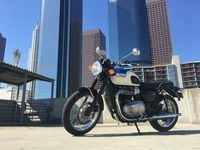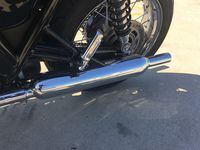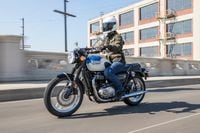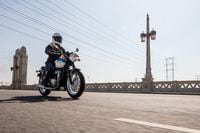We here at Motorcyclist are big fans of the new Bonnevilles, as evidenced by our choice of the Street Twin for our 2016 Motorcycle of the Year . And while Triumph has plenty to be proud of with the completely redesigned Bonneville family, it clearly hasn't been resting on its laurels. In fact, when it comes to the Bonneville lineup, it seems Triumph is just getting started. For 2017 Triumph is releasing the new T100, a mashup of the Street Twin's engine, and the T120 's frame, tank, and styling. We were among only a handful who got first crack at riding the new Bonnie in and around downtown Los Angeles.
So let’s consider this combination of bikes, shall we? The Street Twin, with its 900cc engine’s dynamic torque curve, is a spunky contemporary classic that’s light on its feet, with a small profile. Excellent for the beginner and intermediate riders alike who are simply smaller of stature (or, as I like to say, vertically challenged). Its bigger brother, the T120, with more horsepower and torque, is more refined in its power delivery, and is a larger bike overall. Good for the bigger, more experienced rider who enjoys longer rides (and walks in the rain.) Now the T100 is aimed squarely at the new rider. Triumph calls it the entry level Bonneville, and we can see why: take the smaller Street Twin’s engine and bolt it into the larger, heavier T120 chassis. Give it the same classic styling of the T120 and voila! You’ve got the T100.
Taking off from our hotel basecamp in downtown LA, the T100 feels familiar, with the same torque of the Street Twin, though the throttle response feels less jumpy, more akin to the T120’s mild-mannered “Road” ride mode. The T100 doesn’t offer ride modes like what you’ll find on the T120, so there’s no adjusting it to suit the weather or your mood. Transferring power to the wheels is the same 5-speed transmission as the Street Twin, engaged with a torque-assist clutch.
Tamer throttle response might also be due to the T100's larger frame and portlier weight. Triumph claims the T100's dry weight is 470 pounds, which puts it somewhere in between the Street Twin's 437-lb. and the T120's 494-lb. dry weights (481 and 540 wet, respectively, as measured on our <M>C scales. We're guessing that puts the T100's curb weight at around 516, given its use of the same 3.8-gallon fuel tank as the T120.)
That weight becomes apparent when it’s time to grab a handful of brakes. Using the same Nissin two-pot caliper and single front disc as found on the Street Twin (compared with the T120’s dual discs), the T100 comes to a stop a bit more slowly than either of the bikes it’s made from, requiring a firmer pull on the brake lever than expected. Thankfully the T100 still comes with ABS, which came in handy when a pedestrian stepped out ahead of me during the ride.
With the T100’s frame borrowed from its T120 brother, Triumph claims the seat height to be 31.1 inches, just a scosh higher than the T120. The seat is not quite as soft and cushy, but still comfortable and ready for a long day’s ride. Equally familiar is the reach from seat to handlebars, more stretched out than the Street Twin, but still mostly upright and comfortable for the rider with a taller torso. Longer inseams will be happier too, with what feels like more legroom from seat to footpegs than the Street Twin. With wider and thicker handlebars and even a longer reach to clutch and brake levers, it’s clear the T100 is sized for the average-sized (and larger) rider, just like the T120.
Rolling over much of downtown LA’s cracked and aging concrete-slab roads, the T100’s suspension felt well sorted to soak up the potholes and ruts. Sharper edged ridges, and speed bumps taken at speed (that’s not what they mean by “speed bump”?) are slightly jarring, but not overly so. Bumps taken at slower speed are absorbed well by the KYB suspenders. Overall, the T100 feels better sorted with its suspension than the Street Twin. Even if these are the same fork and shocks, they yield a better ride with the additional 30-plus pounds of the T100. Steering is a bit slower on the T100 than the Street Twin, with a longer wheelbase and shallower rake, same as the T120. This bike is made for a more mellow pace, in contrast to the Street Twin’s nimble traffic-carving persona.
Aside from the chassis being borrowed from the T120, the T100 also takes a lot of other classic design cues from its bigger brother. Dual gauges give tach and speed readouts, with digital inset screens that give info on trip and odometer readings, clock, and miles to empty. A 3-D chrome Triumph badge adorns the tank, though the T100’s is unique from the T120’s. Twin pea shooter exhaust gives the bike a softer classic rumble. Modern amenities are shared with both bikes the T100 is made from: Traction control is standard on the T100, which can be shut off. And there is a USB charge port under the seat. Also, Triumph offers more than 150 accessories to farkle out your T100, with anything from heated grips to luggage and exhaust.
Starting at $10,300, the T100 comes in at a nice midway point between the Street Twin and the T120. The T100 Black, with a completely blacked out engine and exhaust, comes in Jet Black and Matte Black, the latter option costing an extra $250. The T100 comes in Jet Black, Aegean Blue / Fusion White, and Intense Orange / New England White, the two-tone options costing an additional $500. The T100 and T100 Black are available at dealerships now.











/cloudfront-us-east-1.images.arcpublishing.com/octane/YSFOUTYNFBHJV2DYTKGVCFU4R4.jpg)

















/cloudfront-us-east-1.images.arcpublishing.com/octane/2WF3SCE3NFBQXLDNJM7KMXA45E.jpg)
/cloudfront-us-east-1.images.arcpublishing.com/octane/G4MG6OUCJNBSHIS2MVVOTPX65E.jpg)
/cloudfront-us-east-1.images.arcpublishing.com/octane/IIGGWFOTOJGB7DB6DGBXCCMTDY.jpg)
/cloudfront-us-east-1.images.arcpublishing.com/octane/QSTCM6AVEZA5JJBUXNIQ3DSOF4.jpg)
/cloudfront-us-east-1.images.arcpublishing.com/octane/U4I7G625B5DMLF2DVIJDFZVV6M.jpg)
/cloudfront-us-east-1.images.arcpublishing.com/octane/B6XD6LS6IVCQPIU6HXDJSM3FHY.jpg)
/cloudfront-us-east-1.images.arcpublishing.com/octane/ICL63FEDDRDTTMINYICCEYGMDA.jpg)
/cloudfront-us-east-1.images.arcpublishing.com/octane/FCGZHQXRBZFLBAPC5SDIQLVF4I.jpg)
/cloudfront-us-east-1.images.arcpublishing.com/octane/WNOB6LDOIFFHJKPSVIWDYUGOPM.jpg)

/cloudfront-us-east-1.images.arcpublishing.com/octane/X33NU3E525ECRHXLNUJN2FTRKI.jpg)
/cloudfront-us-east-1.images.arcpublishing.com/octane/6KKT5NNL2JAVBOXMZYS5ZO76YA.jpg)
/cloudfront-us-east-1.images.arcpublishing.com/octane/J5RKG5O455GMPGQRF2OG6LRT7A.jpg)
/cloudfront-us-east-1.images.arcpublishing.com/octane/GX2CIZKQVRH2TATDM26KFG2DAE.jpg)
/cloudfront-us-east-1.images.arcpublishing.com/octane/ZWIDYSAKQZHD5BHREMQILXJCGM.jpg)
/cloudfront-us-east-1.images.arcpublishing.com/octane/CYUHJZCTSJCH3MRAQEIKXK7SCQ.jpg)
/cloudfront-us-east-1.images.arcpublishing.com/octane/LKOFINY56FCXJCANJ5M7ZDQUBY.jpg)
/cloudfront-us-east-1.images.arcpublishing.com/octane/4NBPDACMWJH63JQYJVK3QRBDZI.jpg)
/cloudfront-us-east-1.images.arcpublishing.com/octane/KKHQHRR3FJGX7H2IPU6RALMWG4.jpg)

/cloudfront-us-east-1.images.arcpublishing.com/octane/5IOFS5JAE5FOXMNA23ZRAVVYUU.jpg)
/cloudfront-us-east-1.images.arcpublishing.com/octane/CGXQ3O2VVJF7PGTYR3QICTLDLM.jpg)

/cloudfront-us-east-1.images.arcpublishing.com/octane/OQVCJOABCFC5NBEF2KIGRCV3XA.jpg)